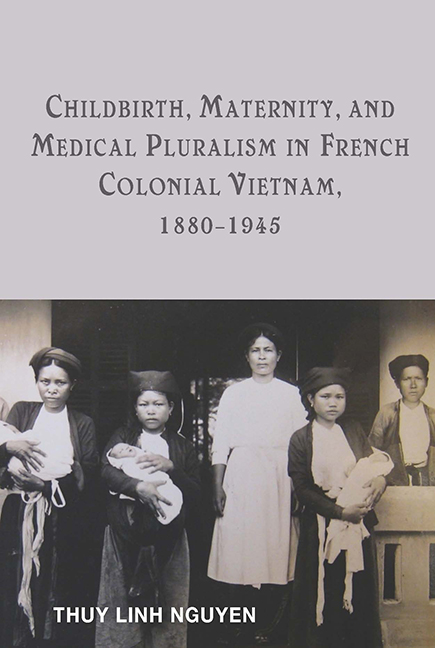Book contents
- Frontmatter
- Contents
- List of Illustrations
- Acknowledgments
- Introduction
- 1 The First Encounters
- 2 Maternity Hospitals
- 3 Colonial Midwives
- 4 The Bà mụ and Childbirth Pluralism
- 5 Scientific Motherhood and the Teaching of Maternity
- 6 The Depression Era and the Discovery of the Child
- Conclusion
- Notes
- Bibliography
- Index
4 - The Bà mụ and Childbirth Pluralism
Published online by Cambridge University Press: 13 July 2019
- Frontmatter
- Contents
- List of Illustrations
- Acknowledgments
- Introduction
- 1 The First Encounters
- 2 Maternity Hospitals
- 3 Colonial Midwives
- 4 The Bà mụ and Childbirth Pluralism
- 5 Scientific Motherhood and the Teaching of Maternity
- 6 The Depression Era and the Discovery of the Child
- Conclusion
- Notes
- Bibliography
- Index
Summary
In the late 1910s and 1920s, despite significant progress in the urban areas of Vietnam, the French maternity services that primarily relied on technical power and Western-trained personnel encountered enormous resistance in rural areas. It was becoming increasingly hard for local midwives to convince the people of the benefits of the new birthing model, since traditional midwives known as bà mụ still played a dominant role in dictating the course of childbirth in these regions. The unsuccessful mission of the Assistance Médicale Indigène (AMI) in rural Vietnam stressed the need for a more localized approach that would take indigenous culture and actors into account. In the late 1920s, in an effort to reach out to the peasant population, the French authority adjusted its medical policy by admitting a number of bà mụ into its healthcare system on the condition that they complete a short training program on hygiene and childbirth. Bà mụ, the marginalized childbirth practitioners who had been blamed for causing the deadly umbilical tetanus, now constituted the core of the midwifery corps in the rural areas. The ruralization of the midwifery personnel marked an important turning point in the development of maternal and infant health care in Vietnam. With the participation of these semiprofessional birth attendants, maternity services became the common playing field for a plural group of childbirth practitioners ranging from French doctors, formal and private colonial midwives, and trained and nontrained bà mụ. The education and employment of the bà mụ also put an end to the colonial state's monopoly over childbirth services, thus paving the way for the emergence of a plural medical system in the 1930s and 1940s.
The incorporation of bà mụ into the state's medical payroll brought into the spotlight the role of Vietnamese midwives, both Western trained and traditional, in the fight against infant mortality. Whereas in France men increasingly controlled obstetrics, in Vietnam the profession had been dominated for centuries by postmenopausal bà mụ who derived prestige and material rewards from assisting in childbirth. Although the emergence of a young generation of French-educated midwives in the late 1900s diversified the forms of birthing services, their presence did not change the fact that childbirth and reproduction in Vietnam exemplified a local knowledge system controlled by women.
- Type
- Chapter
- Information
- Publisher: Boydell & BrewerPrint publication year: 2016

